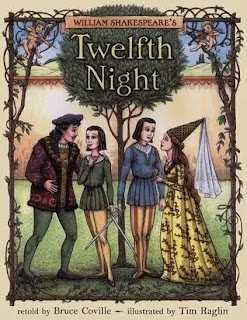INTERWEAVING OF PLOTS IN TWELFTH NIGHT/ STRUCTURE OF TWELFTH NIGHT
“…the plot and underplot (in Twelfth Night) are sorted out…and they are combined into a harmonious whole.’ -A.W. Verity
Shakespeare’s comedies generally have a complex action made up of two or more separate actions and episodes. He may not have invented his own plots, but he certainly shows great skills in harmonizing the various actions into an organic whole. Usually, the main plot or action is tragic and serious, while the under-plot is comic, and the serious action is parodied in the comic sub-plot. Thus, there is a harmonious blending of different elements and this results in the immense variety and perennial appeal of his works. Twelfth Night is no exception in this respect.
The present comedy, too, has a serious main plot dealing with the Orsino-Olivia-Viola love-tangle. The sub-plot is comic and consists of the ‘gulling of Malvalio’, and it also parodies the tragic love theme of the main plot. In the background there is the story of the twins who are separated by ship-wreck, but after various adventures are happily reunited. The story of the main plot and the story of the twins overlap. for Viola’s disguise creates complications in the way of true love, and these complications are removed by Sebastian’s arrival on the scene. In between, there is the duel episode, which is an added complication, and it is also resolved by the arrival of Sebastian.
Shakespeare has shown considerable skill in bringing the two plots into a harmonious combination. First, Lady Olivia serves as an important link between the two plots. She is loved by the Duke, and she herself loves Viola at first sight. The comic characters of the play are also intimately connected with her. Sir Toby is her close relative. Malvolio is her steward, and Feste and Maria are her servants. Thus she is a connecting link between the characters of the main and the sub-plots.
Secondly, the two plots are united into a harmonious whole through the duel episode. It is because of this love for Olivia that Sir Andrew challenges Viola (disguised as Cesario) to a duel. The prompting for this duel comes mainly from Sir Toby. Sir Andrew, mistaking Sebastian to be Viola, attacks him. This brings Sebastian to the presence of Olivia and leads to her hasty marriage with him; in this way, through the duel, the way is cleared for the marriage of Viola and the Duke. The duel introduces complications for Viola, but it also leads to a happy denouement for her. This duel is prompted by the comic characters of the sub-plot, but it clears the ay for the marriage of the heroine of the main plot with the man she loves.
Thirdly, Feste, the clown is another important connecting link. He moves freely between the two households, of the Duke and Lady Olivia, and is also a partner in the plot of the comic characters against Malvolio.
Fourthly, the comic under-plot is a parody or commentary on the serious main plot. Brandes aptly puts it, ‘There is a subtle parody of this love of the Duke for Olivia, and of Olivia for Viola, in the love of Malvolio for his mistress.
True, Twelfth Night is remarkable for its coherent structure and sustained excellence. The plot and sub-plots have been worked out, with no omissions or superfluous details, so that each part is failed to its place. As You Like It, for example, lacks suspense and surprise of drama, because it has no conflict. It is loose in structure with characters like Jaques and Touchstone have no relevance to the plot structure. But Twelfth Night has a coherent structure with all the characters and details dramatically knit together.
